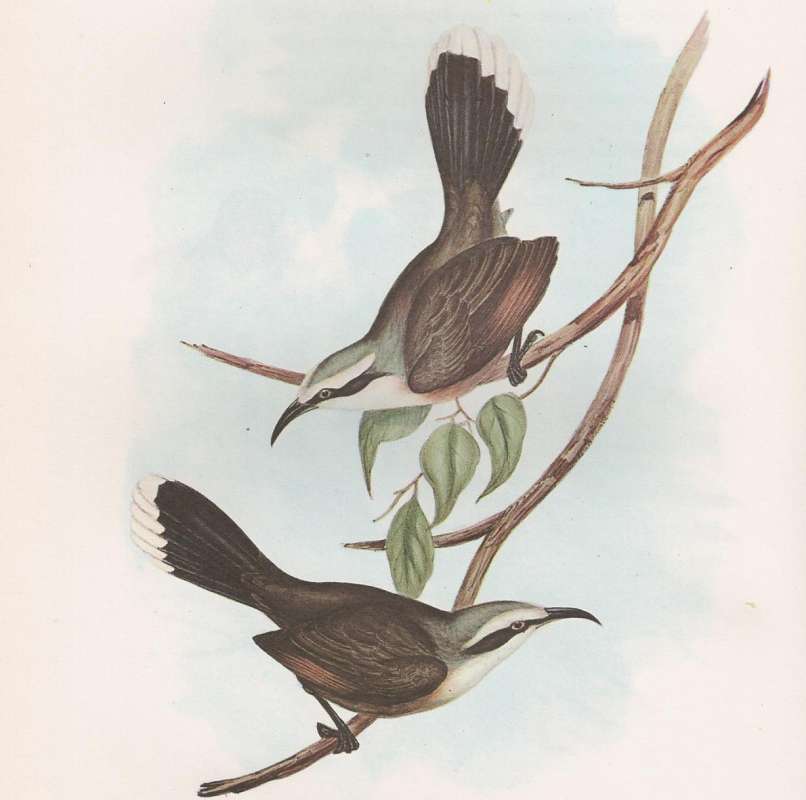SPECIES INFO
Grey crowned babbler (Pomatostomus temporalis) is found in most of western, northern, central, and eastern Australia. This appears absent from southern and southwestern Australia. This 11 to 12 inch bird has a white throat and an orange breast. There is a black eye stripe. Above the black eyestripe there is a white stripe, and above that a gray crown. The tail is black, but white tipped.
There are three subspecies. The nominate subspecies, Pomatostomus temporalis temporalis is found is eastern and south eastern Australia. The subspecies rubeculus is found in northern and central Australia. The subspecies strepitans is found in southern New Guinea.The Babbler genus (Pomatostomus) has 4 species. A closely related species, Garritornis isidorei, is sometimes placed in this genus to make a total of 5 species. These five species can be combined into a family entitled Pomatostomidae. This group of five species is found only in New Guinea and Australia and the nearby island of Misool. The birds in this genus range from about 9 inches to 12 inches in length. They mostly have black eyestripes on a white face.
The 5 species of Australian babblers have had various placements in the taxonomy tree. Recently, in 2003, Howard and Moore gave them their own family. The genera Garritornis(1) and Pomatostomus(4) belong here.
This portion of the Corvoidea is found from south east Asia to Australia. This group contains mostly small to medium sized birds of attractive coloration. Australian robins, fairy bluebirds, leafbirds, log runners, and babblers belong here.
Australian-New Guinea robins(44-45) , fairy bluebirds(2), leafbirds(8), log runners(2), and New Guinea babblers(5) are an assemblage of 5 different taxonomic groups (families) with a limited range from south east Asia to Australia with species that share many characteristics. The families are as listed above as follows: Petroicidae(44-45), Irenidae(2), Chloropsidae (8), Orthonychidae(2), and Pomatostomidae(5).
We have also added the berrypeckers(12) (Family Melanocharitidae) to this group.
In most modern bird taxonomies, the perching birds (Passeriformes) is treated as a single order. This large order has about 5739 different species. A common characteristic of this order is three forward toes and one reverse pointing toe. Most of species are also characterized by a tendon locking mechanism that permits their feet to lock onto branches when they relax. Recently, Monroe and Sibley in 1993 have divided this large order into six main divisions. To help our users navigate this gigantic number of species, we have arbitrarily placed these 6 different divisions at the order level.
This division can be referred to as:
Order Passeriformes (5739 species)
Suborder Passeri (4580 species)
Parvorder Corvida (1103 species)
Aves contains about 8,650 different species of living birds known to science. Each year about one new species is discovered in some remote rain forest or remote island. In addition, scientists have been raising many subspecies to full species status which may raise the species count to 10,000. Birdlife recognizes 10,027 species as of 2011.
However, each year about one species goes extinct. The rate of extinction is increasing, and the rate of new discovery is decreasing, so that the number of bird species will soon begin to decline rapidly. Although different taxonomists would organize the birds differently, there are approximately twenty-seven orders of birds. These orders are broken down into about one hundred and fifty-five different families.
Recent research of the genetic structure of some of the shore birds and owls would indicate that the present organization of orders and families should have some modification.
The birds are a worldwide group of animals that are characterized by having the front limbs modified into wings that are used for flying. Perhaps the most unique feature of the birds is the feathers. These feathers are made up of a central support called a quill and a series of small filaments that are hooked together as barbs.
For many years it was believed that Archaeopteryx discovered in Bavaria was the oldest bird from about 150 million years ago. However, in l986, Sankar Chattterjee, a Texas paleontologist, reportedly discovered a bird in the genus Protoavis that lived about 225 million years ago.
When this project was begun in 1978, we used Austin & Singer for bird taxonomy. Since then, we have adopted many changes, but have kept some older concepts that are still found widely in the literature. Recently, we have used Clements and Howard & Moore. Very recently, we have used Monroe and Sibley for the higher taxonomy of the perching birds.
Backboned Animals (Phylum Chordata) are the most advanced group of animals on earth. These animals are characterized by having a spinal cord or backbone. Most members have a clearly defined brain that controls the organism through a spinal cord. Fish, amphibians, reptiles, birds, and mammals are in this phylum.
Currently, some taxonomists believe that the fish should be divided into two groups (sharks and regular fishes) and that there are some other primitive groups in the phylum such as hagfish or lampreys.
Animal Kingdom contains numerous organisms that feed on other animals or plants. Included in the animal kingdom are the lower marine invertebrates such as sponges and corals, the jointed legged animals such as insects and spiders, and the backboned animals such as fish, amphibians, reptiles, birds, and mammals.

